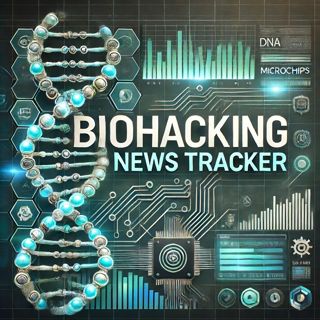
The Booming Biohacking Industry: Mainstream Acceptance and Rapid Sector Growth
Over the past 48 hours, the biohacking industry has shown signs of accelerating maturity and mainstream acceptance as recent events, partnerships, and launches signal rapid sector growth and shifting consumer attitudes. Market estimates show the biohacking sector hit 24 billion dollars in 2024, with the cellular health sub-sector alone valued at 673 million dollars and projected to double by 2035. Interest has surged far beyond its billionaire roots, as demonstrated by the Health Optimisation Summit in London, which drew over 4000 attendees from varied backgrounds and showcased both elite-grade technology and affordable wellness products.Recent days saw key industry events announced, including the upcoming AIMS Symposium and Boston BioLife educational event in Florida, which will unite aesthetic medicine providers, biohackers, and integrative health practitioners, illustrating the blending of traditional medicine and cutting-edge wellness therapies. In new product news, longevity start-up Vivorum launched its Cellular Renewal supplement in Europe this week, targeting sleep and cellular repair with science-backed ingredients and plans for rapid global expansion.Demand trends show consumers are increasingly focused on measurable, trackable results and personalized routines that target metabolic, hormonal, and sleep optimization. This matches a broader convergence with the personal care and beauty industries, as ingredients like NAD plus and advanced biomarker tracking move toward the mainstream, according to Mintel's just-released 2026 Global Beauty and Personal Care Predictions. Ingestible beauty and precision diagnostics are blurring lines between health, wellness, and aesthetics as companies respond to consumer desire for inner and outer transformation.Industry leaders are reacting to supply chain crowding and skeptical consumers by emphasizing scientific validation, narrative-building, and more transparent product education. New entrants face challenges in standing out, with over 50 brands and 150 products now targeting cell health alone.Compared to previous reporting, biohacking has shifted from a niche, fringe practice to a dominant health trend for a broadening customer base, aided by the long tail impact of the pandemic and a persistent distrust of mainstream medicine. No major regulatory changes have emerged in the past week, but increased public scrutiny is visible, and companies are responding with greater focus on clinical evidence and regulatory compliance.While large-scale deals have not been reported in the last 48 hours, the sector’s rapid evolution—reflected in expanding consumer expectations, robust product pipelines, and cross-industry convergence—suggests the disruptive momentum of biohacking is only set to intensify heading into 2026.For great deals today, check out https://amzn.to/44ci4hQThis content was created in partnership and with the help of Artificial Intelligence AI
15 Okt 3min

Biohacking Boom: Transforming Preventive Healthcare with AI, Personalization, and Measurable Results
The global biohacking industry has seen rapid expansion over the past 48 hours, driven by consumer demand for preventive health solutions and data-driven longevity protocols. Major players like Elegant Hoopoe, a Dubai-based company, are transforming biohacking from an elite Silicon Valley trend into mainstream medicine. They offer a 12-week longevity program using AI-generated scores based on 56 biomarkers, with over 30,000 treatments delivered and aggressive expansion planning for over 200 clinics across North America and Europe. This reflects a fundamental shift towards clinically validated, affordable preventive healthcare, where personalized intervention and measurable outcomes are now accessible to professionals, parents, and executives, not just biohacking enthusiasts. Recent client results include up to 10 percent weight reduction, 8 percent muscle gain, and biological age reversal in eight weeks, demonstrating significant efficacy and drawing industry attention.In the broader market, the global biohacking sector is projected to reach 108.57 billion dollars by 2029, nearly tripling in five years. Social media analysis of more than 61 million posts shows biohacking entering mainstream conversations, with a 30 percent annual increase in interest around blood sugar management and a 27 percent rise in talk of personalized supplementation. This consumer shift is mirrored in the functional food category, which was valued at 233.8 billion dollars in 2024 and is on track for 5.45 percent annual growth. Demand for functional foods with specific health benefits, such as probiotics and fortified products, continues to accelerate, particularly in Asia-Pacific, North America, and Europe.New entrants like ShapeScale have launched technologies such as AI-driven 3D body scanners in the past two days, offering medical-grade accuracy and localized feedback for tracking GLP-1-induced weight loss and body composition changes. Their product, debuting in 500 clinics, reported a 20 percent month-over-month revenue growth and strong user outcomes, signaling intense competition and rapid adoption of advanced metrics over traditional methods.Regulatory developments remain a challenge, especially in regions like the United States where minimally studied interventions such as stem cell therapies have yet to gain FDA approval, leaving some experimental practices confined to niche markets. Industry leaders are responding by prioritizing validated protocols, AI-powered insights, and ongoing supply chain optimization, all while competing for consumer trust through ethical sourcing and transparent product claims. Compared with earlier industry reporting, the current period highlights a pronounced shift from experimentation toward standardization and measurable outcomes, making biohacking more mainstream, accessible, and accountable than ever before.For great deals today, check out https://amzn.to/44ci4hQThis content was created in partnership and with the help of Artificial Intelligence AI
14 Okt 3min

Biohacking Goes Mainstream: Data-Driven Health Optimization for the Masses
In the last 48 hours, the biohacking industry has shown both momentum and nuanced shifts, reflecting its rapid transition from niche experimentation to mainstream health optimization. The market continues to attract significant investment, especially in the longevity and personalized health sectors. For example, Dr. Peter Attia’s premium biohacking clinic, Biograph, recently expanded to New York City, targeting high-net-worth individuals with comprehensive diagnostic packages starting at $7,500 annually. These services include advanced metrics like continuous glucose monitoring, full-body MRI, and at-home sleep apnea tests, appealing to consumers demanding data-driven, preventative health strategies. Biograph’s expansion and funding from notable Silicon Valley investors underscore the sector’s appeal to those seeking to extend healthspan, not just lifespan, through precision medicine[3].On the product front, ShapeScale launched the first AI-driven, medical-grade 3D body scanner, offering lifelike visual feedback for users tracking physical changes, a direct response to the growing demand for real-time, actionable health data in the biohacking community[10]. This product launch highlights the increasing integration of artificial intelligence and advanced imaging into consumer health tools.Consumer behavior continues to evolve, with a clear shift toward low-inflammatory, nutrient-dense diets and real-time health tracking. Wearables like Oura Ring, Whoop, and Apple Watch remain central to daily biohacking routines, providing users with metrics on sleep, heart rate variability, and recovery[1]. There’s a parallel surge in interest for personalized nutrition based on DNA and microbiome testing, as seen in discussions at major industry events like SupplySide Global 2025, where sessions focused on microbiome innovations and epigenetic targets for longevity drew attention[5].Regulatory scrutiny is rising, particularly around claims made by wellness brands and the safety of new supplements or devices. Industry conferences are now dedicating sessions to navigating rapid regulatory shifts, including FDA priorities and state-level legislation, indicating that compliance is becoming a strategic concern for market players[5].Supply chains appear stable, with no major disruptions reported in the past week. However, the industry is increasingly focused on sustainability and supply chain resilience, especially for plant-based and synthetic biology-derived ingredients.Compared to earlier in the year, the biohacking market is more crowded, with both established players and new entrants vying for consumer attention. Leaders like Bryan Johnson and Dr. Peter Attia are responding by emphasizing evidence-based protocols and transparency, distancing themselves from unproven “hacks” and focusing on measurable outcomes[3][8]. Meanwhile, the line between traditional healthcare and biohacking continues to blur, as hospitals and employers adopt data-driven wellness programs and recovery systems[1].In summary, the biohacking industry is maturing rapidly, with innovation centered on personalization, real-time data, and scientific rigor. Investment is strong, regulatory pressures are mounting, and consumer expectations are higher than ever—all signs that biohacking is no longer a fringe movement, but a central force in the future of health and wellness.For great deals today, check out https://amzn.to/44ci4hQThis content was created in partnership and with the help of Artificial Intelligence AI
10 Okt 3min

Biohacking Goes Mainstream: Exosome Facials and the Push for Personalized Wellness
In the past 48 hours the biohacking industry has seen notable activity driven by both new product innovation and rising consumer demand for wellness-focused solutions. The most visible recent example is Beyond Facials’ launch on October 8 in Santa Monica of a new biohacking facial, which uses nanoneedling with human-derived exosomes. This treatment is marketed as offering a one hundred times collagen boost with virtually no downtime, distinguishing itself from older techniques like platelet-rich plasma facials. This approach harnesses more than three hundred lab-purified growth factors, promising visible results within a week and lasting effects up to one year. The launch appears to be aimed at luxury and wellness-oriented consumers looking for noninvasive anti-aging substitutes that avoid the inconvenience of more traditional procedures. Client demand for such advanced, efficient skin treatments continues to climb, according to business leaders at Beyond Facials, and early consumer reports highlight rapid improvement in skin hydration, elasticity, and clarity compared to preexisting options. Industry insiders view this commercialization as an example of biohacking principles becoming more mainstream and accessible, beyond the niche markets of early adopters.Elsewhere, planning continues for major events such as Hack Your Health 2025, which in November will connect biohacking leaders, technology innovators, and product makers with health-conscious consumers, reinforcing the sector’s push toward evidence-based wellness solutions. The presence of over one hundred exhibiting brands points to both sustained investment and an increasingly crowded competitive landscape.On a wider scale, analysts suggest that the convergence of biotechnology, personalized wellness, and digital health tools will define the coming year. Research groups like Mintel forecast expanding consumer expectations for measurable results, diagnostic integration, and personalized biomarker monitoring in both skincare and supplementation. Metabolic health, emotional wellbeing, and sensorial experience are emerging as critical consumer drivers, with product launches increasingly required to provide both technical proof and a holistic, emotionally resonant brand story.Compared to recent quarters, biohacking industry leaders are increasingly emphasizing transparent science and customized outcomes in response to regulatory scrutiny and demands for real-world efficacy. As new, highly technical products hit the market and partnerships between clinics and tech companies multiply, the pace of innovation and the bar for clinical evidence appear higher than at any point in the past year.For great deals today, check out https://amzn.to/44ci4hQThis content was created in partnership and with the help of Artificial Intelligence AI
9 Okt 2min

Biohacking Boom: Personalized Health, Longevity, and the Evolving Wearables Market
The biohacking industry has experienced significant activity over the past 48 hours, reflecting broader shifts towards preventative health, emerging competitors, and increasing consumer interest in longevity solutions. Market momentum is driven by both established players and disruptive startups eager to capitalize on the demand for personalized health technologies and novel therapeutics.One of the most notable market movements comes from Canadian telehealth startup Felix, which just expanded its services to launch a subscription-based longevity testing and monitoring platform. The program offers annual biomarker testing and ongoing health tracking at 500 dollars per year, addressing over 35 health markers including metabolic, hormonal, and inflammation metrics. Felix reported 80 percent year-over-year growth and a doubling of patient numbers between January and August, with strong demand for its weight loss program using GLP-1 drugs. The company is also preparing for the expiration of Novo Nordisk’s Ozempic patent in Canada, collaborating with manufacturers to secure lower-cost generic options and ensure stable supply, highlighting active supply chain management in the sector. Felix’s expansion reflects a general trend among biohacking firms to offer more preventative solutions as a response to overstrained traditional healthcare systems and rising consumer impatience with inaccessible care. Over a third of Canadians now turn to digital health platforms due to lack of primary care access, a trend mirrored in other markets and driving sector growth[1].Product innovation also continues at pace, with increased competition among health wearables as leading products like the Oura Ring Gen 4 face challenges from competitors such as Samsung, Ultrahuman, and smaller specialty brands. Oura’s emphasis on new AI-based coaching, enhanced sensor technology, and more intuitive health reporting demonstrates a turn towards data-driven, user-personalized experiences. These wearables now integrate seamlessly with health apps and offer more granular tracking of factors from sleep to hormonal cycles, catering to an audience eager for biofeedback and optimization tools. Market analysts report continued growth, but some note rising consumer skepticism about data privacy and the necessity of subscription models[4][5].The culture of extreme self-experimentation remains prominent, with figures like Bryan Johnson, who reportedly spends two million dollars annually on advanced biohacking protocols, fueling public curiosity but also debate over the balance between science and spectacle. Meanwhile, no major regulatory changes or supply shocks have been reported in the past week, although the competitive landscape is tightening as both large and small players move to solidify market share[7].In sum, the current state of biohacking reveals rapid product evolution, surging demand for preventative and longevity solutions, greater scrutiny on outcomes and ethics, and aggressive positioning by industry leaders as the sector transitions from fringe to mainstream health innovation[1][4][5][7].For great deals today, check out https://amzn.to/44ci4hQThis content was created in partnership and with the help of Artificial Intelligence AI
8 Okt 3min

Biohacking Industry Soars: Personalized Health and Cognitive Enhancement Driving Rapid Growth
The biohacking industry has seen significant developments in the past 48 hours, signaling a phase of robust growth and innovation as the sector heads toward 2026. U.S. market data indicates an aggressive upward trajectory, with biohacking revenues forecast to jump from about 36 billion in 2024 to over 45 billion dollars in 2025, maintaining a compound growth rate exceeding 19 percent in some segments. Key drivers include increasing consumer interest in personalized health, the rise of chronic illness, and new technologies in wearable and cognitive enhancement products. Market leaders such as Neurohacker Collective, Bulletproof 360, Thorne, and HVMN are spearheading this expansion by launching new product lines and forming partnerships focused on nutritional supplements, genetic testing, and sleep optimization tools.In the last week, several large players have announced strategic alliances to streamline supply chains and innovate distribution, responding to rising consumer demand for fast, direct-to-door health solutions. Industry conferences, like the LA Biohacking Conference, have underscored a surge in venture funding and highlighted opportunities for startups in mental wellness and performance tracking. New product launches—particularly in smart wearables and customizable supplements—are outpacing traditional offerings, with companies investing in direct digital engagement and remote monitoring services to keep up with changing buyer preferences.Recent regulatory signals out of the U.S. and Europe suggest a tightening but not yet restrictive stance on biotech-derived biohacking kits and innovative supplement formulas. Leaders are proactively adjusting user claims, refining documentation, and engaging with regulators on quality standards to maintain momentum and avoid disruption.Against the backdrop of rapid market expansion, price volatility has moderated relative to 2023, although inputs for wearable electronics and custom supplements remain under some cost pressure due to global supply chain constraints. Consumer behavior has shifted further toward do-it-yourself biology and data-centric health optimization, with an emphasis on measurable outcomes and user control, pushing companies toward transparent labeling and outcomes-based marketing.Compared to six months ago, the current landscape is defined by larger investment rounds, more rapid product uptake, and greater mainstream acceptance, positioning the biohacking industry at the forefront of consumer-driven health transformation.For great deals today, check out https://amzn.to/44ci4hQThis content was created in partnership and with the help of Artificial Intelligence AI
6 Okt 3min

The Rise of Biohacking: Democratizing Anti-Aging and Personalized Health
In the past 48 hours, the biohacking industry has shown significant dynamism, reflecting broader trends in anti-aging and health technologies. Recently valued at 24.8 billion dollars in 2024, the anti-aging market, which includes biohacking, is expected to grow to 69.1 billion dollars by 2030, according to Grand View Research[1].Recent events like the Medical Spa Show 2025 highlighted innovations in biohacking alongside ultrasound and other aesthetic technologies, showcasing the industry's focus on integrating cutting-edge treatments[2]. However, there is also increasing scrutiny on compliance and safety standards, underscoring the need for regulation and ethical practices within the medical aesthetics sector[2].Dave Asprey, a prominent figure in biohacking, emphasizes making these technologies more accessible. He suggests that while some treatments may be expensive, there are also low-cost alternatives like supplements and lifestyle changes that can achieve similar goals[3]. Asprey's views highlight a shift towards democratizing biohacking, making it more inclusive beyond its current elite and expensive perceptions.In terms of market movements, there are no specific recent deals or partnerships reported in the past week. However, the general trend is towards greater integration of technology and personalized health solutions, with companies like Asprey's Upgrade Labs focusing on data-driven health optimization[3]. Despite these advancements, regulatory challenges persist, and industry leaders are responding by emphasizing compliance and safety to protect both consumers and businesses[2]. Overall, the biohacking sector is evolving rapidly, with a push towards more accessible, data-driven health solutions.For great deals today, check out https://amzn.to/44ci4hQThis content was created in partnership and with the help of Artificial Intelligence AI
1 Okt 1min

Biohacking's AI-Powered Health Revolution: Transforming Longevity and Self-Optimization
The biohacking industry has experienced significant momentum in the past 48 hours, with a surge of new product launches, partnerships, and market activity underscoring its rapid growth. The fusion of artificial intelligence and health optimization has emerged as the sector’s most transformative trend. As of 2025, over 340 FDA-approved AI health tools are in use, with the market for AI-driven healthcare ballooning to over 32 billion dollars this year and projected to surpass 430 billion by 2032. Investor interest is robust, fueled by an average return of $3.20 for every dollar invested in health AI, with results typically achieved within 14 months. High demand is visible at events like the Biohackers World Conference, which recently attracted over 700 participants in Chicago and features Miami as its next stop, reflecting a dedicated community around longevity, wearables, and self-optimization.Recent deals and product launches point to fierce competition. On September 25, ShapeScale announced the first AI-powered 3D body scanner, tailored for the rise of GLP-1 weight loss drugs and the biohacking market. Lifestack 2.0 launched a new wearable platform focused on smarter daily planning using real-time health data. Premium biohacking clinics such as Dr. Peter Attia’s Biograph are expanding rapidly, charging up to $15,000 a year for continuous personalized analytics and full-body tracking, and reported a 15 percent discovery rate of urgent health insights in users. Meanwhile, startups like Biohelping are positioning themselves as alternatives by shifting focus from biohacking to a broader, data-driven healthspan movement.Consumer behavior has moved decisively toward measurable, trackable results as skepticism toward generic wellness fades. Forty-nine percent of AI healthcare revenue is generated in the US, and 60 percent of digital health users now interact regularly with AI medical assistants. However, data privacy and transparency remain challenges, with 68 percent of US adults expressing fears that AI use could erode the patient-provider relationship. Compared to last year, the sector is more fragmented, with new entrants and technologies accelerating disruption and innovation at an unprecedented rate. Regulatory scrutiny is increasing, yet product launches and venture funding suggest market optimism remains high. The coming months are likely to see further strategic alliances, with established and emerging biohacking leaders rapidly adapting to changing consumer and regulatory demands.For great deals today, check out https://amzn.to/44ci4hQThis content was created in partnership and with the help of Artificial Intelligence AI
26 Sep 2min





















